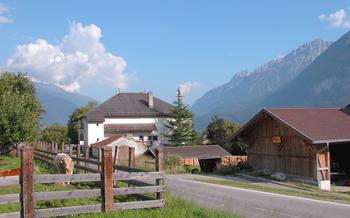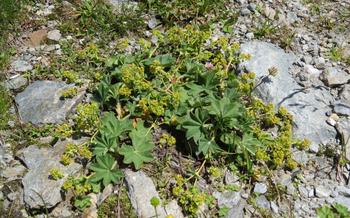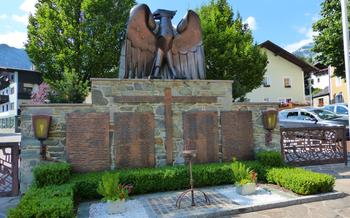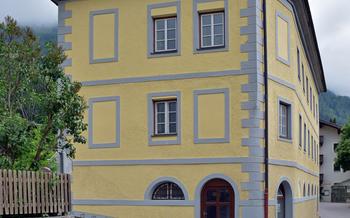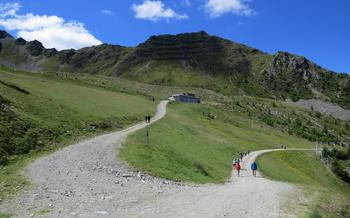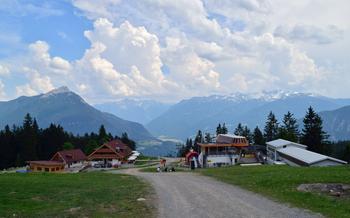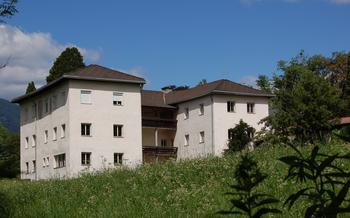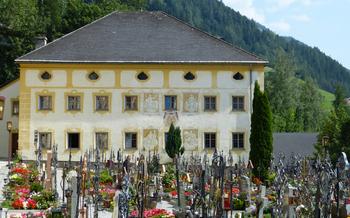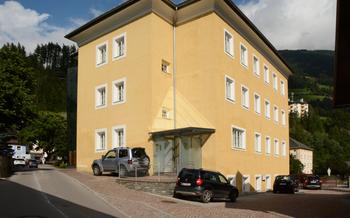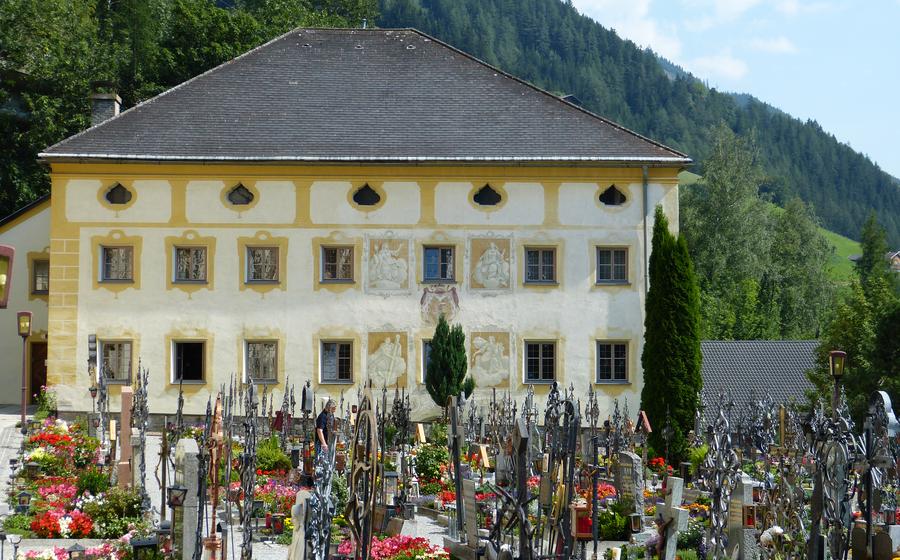
Aguntum Roman City Museum
- The Aguntum Roman City Museum: A Journey Through Ancient History
- Historical Background
- Architectural Remains
- Exhibitions and Displays
- Educational Programs
- Research and Archaeological Work
- Visitor Experience
- Surrounding Attractions:
- Transportation and Accessibility
- Historical Significance
- Ancient Artifacts
- Interactive Exhibits: Bringing Aguntum's History to Life
- Educational Resources:
- Insider Tip: Unveiling the Hidden Treasures of Aguntum
The Aguntum Roman City Museum: A Journey Through Ancient History
Nestled in the heart of Matrei in Osttirol, Austria, lies a treasure trove of ancient history waiting to be explored: the Aguntum Roman City Museum. This remarkable museum takes visitors on a journey back in time to the days of the Roman Empire, showcasing the fascinating remnants of a once-thriving Roman city.
Aguntum, strategically located at the crossroads of important trade routes, played a crucial role in the Roman Empire's expansion and administration. The museum houses a wealth of artifacts unearthed from the extensive excavations conducted at the site, providing a glimpse into the daily lives, culture, and customs of the Roman inhabitants.
Among the museum's highlights are exquisite sculptures, intricate mosaics, and finely crafted pottery, all of which attest to the artistic prowess and craftsmanship of the Romans. These artifacts offer a tangible connection to the past, allowing visitors to imagine the bustling streets, vibrant markets, and opulent villas that once characterized this ancient city.
The Aguntum Roman City Museum is not merely a repository of artifacts; it is a dynamic and engaging space that brings history to life. Interactive exhibits, educational programs, and guided tours make this museum an ideal destination for visitors of all ages, fostering a deeper understanding of Roman culture and its enduring legacy.
Historical Background
The Roman Empire's influence extended far beyond its heartland in Italy, reaching deep into the provinces and leaving an indelible mark on the regions it conquered. Austria, once a part of this vast empire, bears witness to this rich legacy, and the ancient Roman city of Aguntum stands as a testament to this bygone era.
Aguntum's strategic location at the confluence of two rivers made it a crucial hub for trade and commerce. Its position on the Roman road network, connecting it to major cities and military outposts, further enhanced its importance. As a thriving center of administration, Aguntum played a pivotal role in governing the surrounding region.
Beneath the surface of this ancient city, a wealth of artifacts and ruins awaits discovery. Excavations have uncovered the remains of public buildings, temples, and residential structures, providing glimpses into the daily lives of the Roman inhabitants. Inscriptions and mosaics narrate tales of their culture, beliefs, and customs, offering a window into a distant past.
Aguntum's integration into the Roman Empire brought significant changes to the region. Roman engineering feats, such as the construction of roads and aqueducts, transformed the landscape and facilitated the movement of goods and people. The introduction of Roman laws, administration, and coinage brought order and structure to the province.
In Aguntum, the spirit of the Roman Empire lives on, preserved in the ruins and artifacts that speak of a time when this ancient city stood as a beacon of civilization on the frontiers of the Roman world.
Architectural Remains
The Aguntum Roman City Museum offers a captivating journey through the architectural grandeur of ancient Rome, showcasing the city's remarkably preserved structures. Its sturdy city walls, fortified with towers and gates, stand as a testament to the Romans' engineering prowess and provided protection from potential threats. The main gate, known as the Porta Principalis Sinistra, served as the city's primary entrance, welcoming visitors and trade.
Within the city walls, the ruins of various public buildings, including temples, baths, and an impressive amphitheater, evoke a sense of awe and wonder. The temples, dedicated to Roman deities, feature intricate carvings and sculptures depicting mythological scenes, offering a glimpse into the religious beliefs of the city's inhabitants. The amphitheater, with its well-preserved seating tiers, hosted gladiatorial contests and public performances, providing entertainment and spectacle for the Roman citizens.
The baths, with their elaborate heating systems and mosaic floors, attest to the Romans' emphasis on hygiene and leisure. These communal spaces served as places for socializing, relaxation, and rejuvenation. The remains of shops, workshops, and warehouses hint at the bustling commercial activity that once took place within Aguntum's walls.
The ongoing efforts to conserve and restore these ancient ruins ensure that visitors can continue to marvel at the architectural achievements of the Roman Empire. The Aguntum Roman City Museum provides a unique opportunity to explore and appreciate the tangible remnants of a civilization that shaped the course of European history.
Exhibitions and Displays
The Aguntum Roman City Museum houses a wealth of artifacts, models, and multimedia presentations that bring the ancient city to life. The permanent exhibition, titled "Aguntum - City of the Romans," takes visitors on a journey through the history of the city, from its foundation to its decline. Visitors can explore the various aspects of Roman life, including trade, administration, religion, and everyday life. The museum also features a temporary exhibition space that hosts rotating exhibits on specific themes related to Roman history and archaeology.
A highlight of the museum's collection is the impressive collection of sculptures, including statues of Roman deities, emperors, and ordinary citizens. These sculptures provide a glimpse into the artistic and cultural traditions of the Roman inhabitants of Aguntum. The museum also displays a variety of mosaics, pottery, coins, and jewelry, which offer insights into the daily life and economy of the city.
The Aguntum Roman City Museum also features a number of interactive exhibits that allow visitors to engage with the history and culture of Aguntum in a hands-on and immersive way. These exhibits include a virtual reality experience that takes visitors on a tour of the ancient city, an interactive map that shows the extent of the Roman Empire, and a 3D model of the amphitheater.
Throughout the year, the museum also hosts special events and workshops that provide visitors with an opportunity to learn more about Roman history and archaeology. These events often feature guest speakers, hands-on activities, and guided tours.
Educational Programs
The Aguntum Roman City Museum offers a range of educational programs tailored to suit different age groups and learning styles. These programs aim to promote cultural heritage and history through interactive learning experiences.
For school groups, the museum provides guided tours that bring the ancient Roman city to life. Students can explore the ruins, learn about the daily lives of the Roman inhabitants, and engage in hands-on activities that reinforce their understanding of history.
Families with children can participate in workshops and activities designed specifically for young learners. These programs use storytelling, games, and interactive exhibits to make history fun and accessible. Children can dress up in Roman costumes, play Roman games, and create their own Roman crafts.
Individual visitors can take advantage of the museum's self-guided audio tours, which offer insights into the history and significance of Aguntum. Visitors can also join guided tours led by knowledgeable museum staff who share their expertise and answer questions.
The museum's educational programs are an excellent way to learn about Roman history and culture in a fun and engaging way. They provide a valuable resource for teachers, parents, and individuals who want to explore the rich heritage of Aguntum.
Research and Archaeological Work
The Aguntum Roman City Museum is not merely a repository of ancient artifacts; it is also an active center of archaeological research and exploration. Ongoing excavations at the Aguntum site provide a glimpse into the meticulous work of archaeologists as they uncover the secrets of this ancient city.
Archaeologists employ a range of methodologies to uncover and document ancient remains. They carefully excavate the site, using hand tools and brushes to gently remove layers of soil and reveal the underlying structures. They meticulously record their findings, taking detailed notes, photographs, and measurements.
One of the challenges faced by archaeologists is the preservation of the delicate remains. Over time, the passage of centuries and the elements have taken their toll on the ruins. Archaeologists must work diligently to stabilize and conserve these fragile structures, ensuring their preservation for future generations.
Through their painstaking efforts, archaeologists have made significant discoveries that have shed new light on Aguntum's past. Recent excavations have revealed well-preserved streets, houses, and public buildings, providing valuable insights into the daily life and urban planning of the Roman city.
Visitor Experience
Planning a visit to the Aguntum Roman City Museum is an enriching experience that offers a glimpse into the fascinating history of the ancient Roman city. The museum is open to the public from Tuesday to Sunday, with varying hours depending on the season. Admission fees are reasonable, and there are discounts for students and seniors. The museum is wheelchair accessible and provides facilities for visitors with disabilities.
Before your visit, consider exploring the museum's website or contacting them to learn about any special events or workshops that may be taking place during your stay. Guided tours are available in several languages and offer an in-depth insight into the history and significance of Aguntum. These tours are led by experienced guides who bring the ancient city to life with their knowledge and passion.
When visiting the museum, allow ample time to explore the various exhibits and displays. The museum's layout is user-friendly, with clear signage and information panels in multiple languages. Take your time to admire the well-preserved artifacts, models, and multimedia presentations that showcase Aguntum's rich history and culture.
Remember to bring your camera to capture the stunning views of the surrounding landscape and the impressive Roman structures. The museum also features a gift shop where you can purchase souvenirs, books, and replicas of ancient artifacts as mementos of your visit.
Whether you're a history buff, an archaeology enthusiast, or simply someone curious about the Roman past, the Aguntum Roman City Museum promises an unforgettable journey through time. Immerse yourself in the ancient world, discover the secrets of Aguntum, and let the spirit of the Romans come alive as you explore this remarkable museum.
Surrounding Attractions:
When exploring the Aguntum Roman City Museum, don't miss the opportunity to delve deeper into the region's rich Roman history by visiting nearby attractions. Just a short drive away, you can discover the Roman City of Teurnia, another significant Roman settlement that boasts impressive ruins, including an amphitheater, a forum, and a temple complex. Immerse yourself in the daily life of ancient Romans as you wander through the excavated streets and admire the well-preserved mosaics and frescoes.
For a unique perspective on Roman engineering, head to the Roman Bridge in Lienz, a remarkable testament to the Romans' architectural prowess. Built in the 1st century AD, this bridge spans the Drava River and continues to serve as a vital transportation link to this day. Marvel at its sturdy construction and imagine the countless travelers and traders who have crossed it throughout the centuries.
To gain a broader understanding of the Roman Empire's influence in the region, consider visiting the Tiroler Landesmuseum Ferdinandeum in Innsbruck. This renowned museum houses a vast collection of artifacts, including Roman sculptures, inscriptions, and pottery, that shed light on the cultural and political significance of Roman rule in Tyrol. Explore the exhibits and learn about the region's transition from a Celtic kingdom to a Roman province, and the lasting impact of Roman rule on its history and culture.
These surrounding attractions offer a comprehensive journey through Roman history, allowing you to delve deeper into the lives and achievements of the ancient Romans who once called this region home.
Transportation and Accessibility
Reaching the Aguntum Roman City Museum is a breeze, with various transportation options available. For those embracing the scenic route, the drive through the stunning Tyrolean countryside offers breathtaking views. Ample parking spaces are available near the museum, ensuring a convenient arrival. Visitors utilizing public transportation can hop on the regional bus service, which makes frequent stops at the museum's doorstep. The museum's accessible design caters to visitors with limited mobility, featuring wheelchair ramps, elevators, and designated accessible restrooms. Guided tours tailored for individuals with disabilities are also available upon request, ensuring an inclusive and enriching experience for all.
Historical Significance
Aguntum's historical significance lies in its role as a pivotal Roman city that played a crucial part in the development of the region. During the Roman Empire, Aguntum served as a significant administrative center, overseeing a vast territory that encompassed present-day East Tyrol and parts of Carinthia. This strategic location allowed the Romans to effectively control trade routes and maintain a strong military presence in the area. Furthermore, Aguntum's position as a thriving commercial hub facilitated the exchange of goods and ideas between different parts of the empire, contributing to the region's economic prosperity. The city's legacy extends beyond its political and economic importance, as it also served as a cultural and intellectual center, where Roman customs, laws, and traditions were disseminated throughout the region. Aguntum's enduring impact can still be seen in the cultural heritage and traditions of the present-day inhabitants of East Tyrol, who proudly trace their roots back to the ancient Roman city.
Ancient Artifacts
Among the many unearthed treasures at Aguntum, several artifacts stand out for their exceptional significance and beauty. One such artifact is a remarkably well-preserved bronze statue of Mercury, the Roman god of trade and travel. This life-size statue, dating back to the 2nd century AD, showcases the exquisite craftsmanship and artistic prowess of the Roman artisans. The statue's intricate details, from the winged helmet to the flowing cloak, provide a glimpse into the religious beliefs and artistic traditions of the Roman inhabitants of Aguntum.
Another notable artifact is a stunning mosaic floor depicting a vibrant scene of marine life. Discovered in the ruins of a Roman villa, this mosaic features a variety of sea creatures, including fish, dolphins, and even a mythical sea monster. The intricate design and vivid colors of the mosaic offer a glimpse into the luxurious lifestyle and artistic sensibilities of the Roman elite who once resided in Aguntum.
Furthermore, the museum houses an impressive collection of Roman pottery, coins, and jewelry, each piece offering valuable insights into the daily life and economy of the ancient city. These artifacts showcase the diverse range of goods that were traded and used by the Romans, from utilitarian pottery vessels to finely crafted jewelry adorned with precious gemstones.
Interactive Exhibits: Bringing Aguntum's History to Life
The Aguntum Roman City Museum boasts a range of interactive exhibits and displays that bring the ancient city's history and culture to life in a captivating way. Visitors can engage with the past through virtual reality experiences, where they can step back in time and explore the streets of Aguntum, witnessing daily life and events as if they were there. Interactive maps and 3D models allow visitors to visualize the city's layout and architecture, gaining a deeper understanding of its urban design. Multimedia presentations and touchscreens provide in-depth information on various aspects of Roman culture, from religion and mythology to trade and administration. These interactive elements enhance the museum experience, making it both educational and entertaining for visitors of all ages.
Educational Resources:
The Aguntum Roman City Museum offers a range of educational resources to enhance the learning experience for visitors of all ages. Guided tours led by knowledgeable guides provide an in-depth exploration of the museum's exhibits and the history of Aguntum. These tours are tailored to different age groups and interests, ensuring that everyone can gain valuable insights into Roman culture and history.
In addition to guided tours, the museum offers educational materials such as interactive worksheets, activity sheets, and hands-on exhibits designed to engage children and families. These resources make learning about Roman history fun and interactive, allowing visitors to immerse themselves in the past and discover the wonders of Aguntum.
The museum also hosts workshops and educational programs throughout the year, providing opportunities for visitors to learn new skills and gain a deeper understanding of Roman culture. These programs cover various topics, including Roman cooking, pottery, and architecture, allowing participants to experience Roman life firsthand.
By utilizing these educational resources, visitors can gain a comprehensive understanding of Roman history and culture, making their visit to the Aguntum Roman City Museum a truly enriching and educational experience.
Insider Tip: Unveiling the Hidden Treasures of Aguntum
Beyond the main exhibits of the Aguntum Roman City Museum, there lies a hidden gem waiting to be discovered. As you stroll through the ancient ruins, keep an eye out for a secluded corner where you'll find a collection of remarkably preserved Roman coins. These coins, each bearing intricate designs and inscriptions, offer a glimpse into the economic and cultural life of Aguntum's inhabitants. Imagine the stories they could tell if they could speak! Take your time to examine these precious artifacts and transport yourself back in time to the bustling streets of this ancient Roman city.
